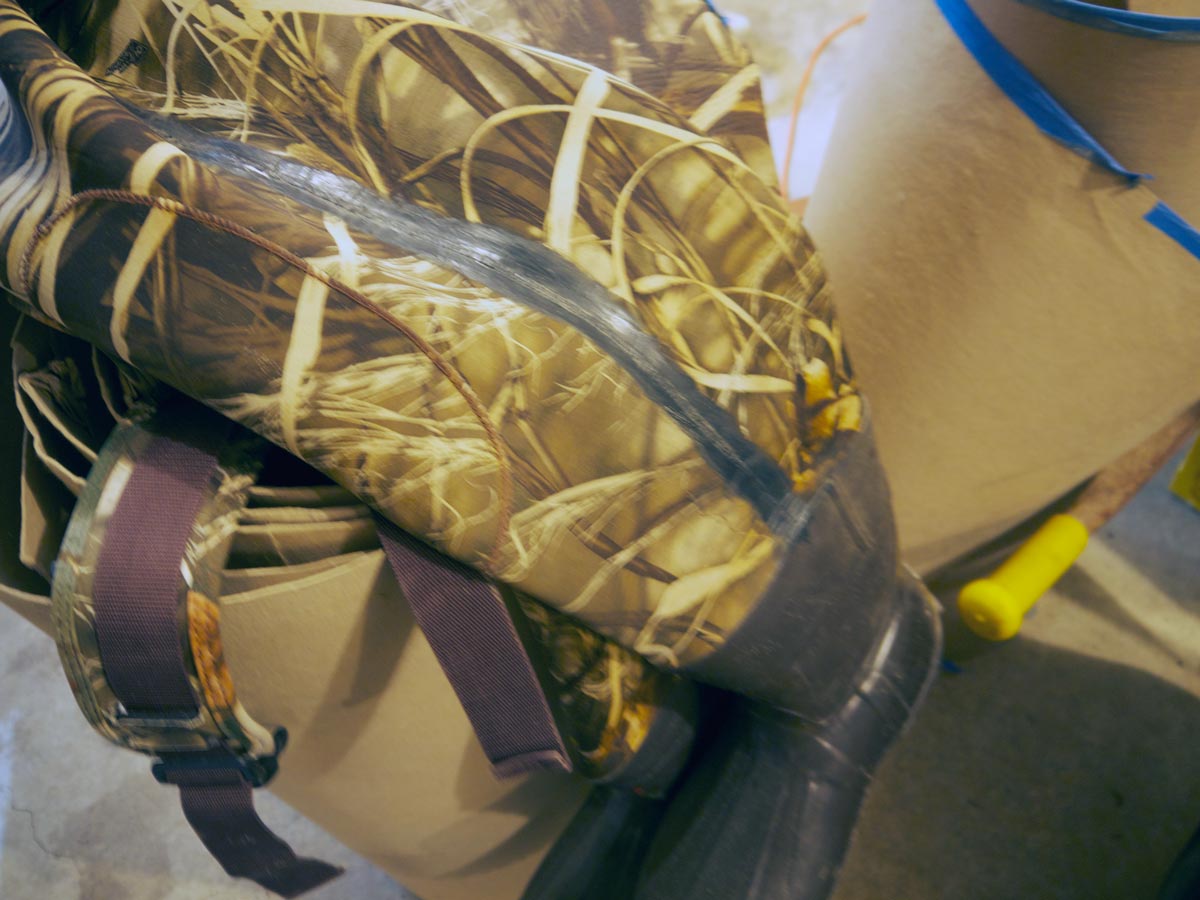As I was starting my third waterfowl season I ran into the inevitable problem of leaky waders. It started pretty innocuously early in the season. After the hunt I stripped off the waders and noticed one of my socks was wet, not soaked but wetter that sweaty-wet to be sure. Since I always wear a thick wool blend sock I didn’t really even notice it in the field.
In the garage I began to investigate and found a pin-hole at the seam of the knee pad. I bought a product called Aquaseal, which is a pretty standard patching solution, and applied it to the hole. Problem solved … for about two hunts.
It was then I began to notice other, more sensitive places getting wet. Sitting in a cold blind with soggy underwear quickly begins to change your demeanor. Not only was I colder and grumpier, I found myself eager to hoof out on retrieves of my buddy’s birds just so I could warm up a little, even if that meant getting a little more waterlogged. This interruption to my normal laziness meant it was back to the garage.
This time I found a few holes on the inseams, especially in the crotch. I went back the AquaSeal and smeared it on like cream cheese throughout the leaky parts of the seams. I used the entire tube and thought I had the problem licked. The next hunt proved that wrong. I needed another solution as half the hunting season remained. Having just upgraded my shotgun, I was not interested in buying a new pair of waders. I don’t remember exactly where I stumbled upon the solution (maybe a thread in DuckHuntingChat.com or the waterfowl thread in Hunt-Washington.com) but what I found was like Manna from Heaven for the waterfowler: a cheap fix that really does work!
Works for Breathable Waders as Well
Update: It’s been three seasons since I wrote this and in that time I switched from neoprene waders to breathable waders. I’m happy to report that the fix below works for breathable waders as well. If you’re interested in why I switched, check out my review on neoprene vs. breathable waders.
Hello Plasti Dip
If you’ve ever looked in your toolbox and found a pair of pliers with rubber-coated grips then you’re familiar with Plasti Dip. It’s basically a viscous rubber that dries and hardens into a strong and flexible rubber coating. It’s also one of those wonder products that people are using for all sorts of unintended things: hand weights, skateboards, wedding rings, car wheels and even entire cars. And I used it to entomb the leaky seams of my waders in a flexible rubber shell inside and out. The patching was not pretty but it worked. The last hunts of the season, in the coldest weather, were the driest for me.
What you need:
- Can of black Plasti Dip (I found mine at a local hardware store for about $8.)
- 3-4 1-inch foam paint brushes (Once you use them you will throw them away.)
- Latex gloves
- Paint respirator (This was the most expensive item.)
- Paper plates
- Tall step ladder or old chair
- Flashlight or shop light
- Blue painter’s tape
- Very well ventilated area like an open garage (The warnings on the label make this clear, too.)
- Box fan or shop fan to ventilate your space and to dry and cure your patch
- About 48 hours, allowing for curing time
 What you do:
What you do:
- Find the Hole or Holes – Grab your painter’s tape and tear off a few squares and keep them handy. Turn the lights out in your garage and make it as dark as possible. If you can’t get it dark in the garage try this in an interior room of the house. Put the flashlight inside the waders and press the beam end against the neoprene along the suspected leaking areas and start looking for the light. If there are holes you will see the light easily. Mark the holes with the squares of tape. (Some people say they fill the waders with water and look for leaks that way. Sounds too messy for me and then you have to wait for the waders to dry.)
- Prep the Surface – Basically you want the fabric to be free of dirt and relatively clean before you begin. My waders still had plenty of Aquaseal on some parts of the seams that was not going to come off without further damage to the waders so I left it on. It didn’t seam to cause a problem.
- Prep the Curing Area – Once you’ve applied the Plasti Dip you will need to let it cure, preferably overnight. That means you’ll need a spot for your waders so they can lay open without having the patched area touching another section of the wader and welding to it. I used a 10-foot step ladder for this, hanging the waders from it using a hanger or by the boots. You could probably rig something with an old chair as well.
- Apply the Plasti Dip – Turn the waders inside-out. Open the garage, turn on the fan, put on the gloves and respirator grab a foam brush and open the can of Plasti Dip. You can just spot repair the holes you marked with tape by dipping the brush into the Plasti Dip and then applying it to the area, pushing it into the hole or seams as you go. Cover your bases with a half- to one-inch overrun, as well. Since I was fighting failing seams I did all the seams, from the boot tops all the way up to the crotch and back down again, dabbing and pushing, then smoothing with the foam brush. (I could have made this a lot neater by taping my overruns on each side of the seams but I didn’t think about it. My final product wasn’t pretty but it did work.) Carefully put the waders on your curing area and leave them to cure, preferably overnight. Close the Plasti Dip lid or it will harden. Place the used brush on the paper plate to throw away later. The next day apply the Plasti Dip to the other side of the patch or seams.
This worked for me and I hope it will for you, too. If you have something to add, please leave a comment below!


3 Comments. Leave new
Thank you for this.
Did you use the spray can or liquid type can?
I’ve used both. Right now I use the spray can because it goes a bit faster.